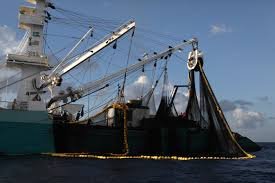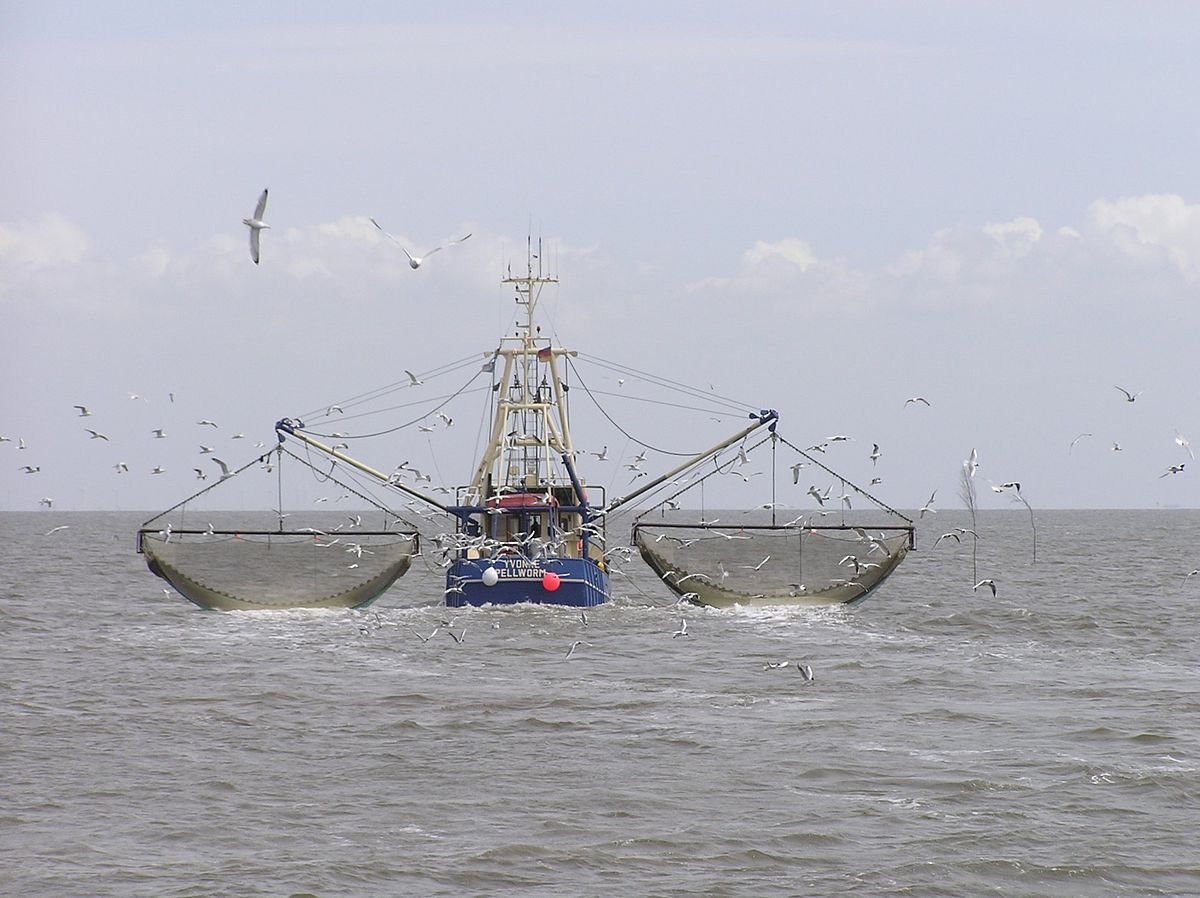What happens when all the fish are gone?
Impact of the seafood industry
Our seafood comes from two places: the ocean and aquaculture. Wild seafood comes from the wide-open ocean and aquaculture (farmed seafood) comes from controlled environments, i.e., underwater tanks, ponds, or sea cages. There are issues with both, stemming from an industry capitalizing on the natural world and its natural capital.
How many times a week do you eat seafood? At one trillion wild-caught fish per year, it’s fair to say that globally, we consume a sizable percentage of seafood. Note: that figure doesn’t account for the farmed gobbled seafood. Let's dive into what led to the current state of seafood.
It all started with a collective misconception that the ocean has infinite resources, fish stocks, and resilient systems that can not be broken. This misconception was born due to large-scale industrial fishing. Oceans o’plenty right? Wrong!
Fact: the ocean has limited resources. The ability to catch mass quantities of fish at the top of the food chain and unwanted bycatch(unintentionally caught fish) leads to dysfunctional aquatic food chains, which leads to massive ecosystem imbalances.
What happens when all the fish are gone?
The fishing industry loses revenue once they push a species to depletion in the wild via overfishing this results in an influx of demand for aquaculture (farmed fishing). Then government subsidies become necessary to financially sustain unsustainable fishing practices, to continue industry as usual.
Currently, the ocean is struggling with a total degradation of entire ecosystems, genetically modified fish, pollution through emissions and chemical enhancements… Which may lead to the extinction of all wild aquatic life except for jellyfish, the cockroaches of the ocean. Jellyfish crabby patty anyone?
All the above means that your demand matters. If you are eating seafood 7 days a week this is a good opportunity to reduce that number. If we all switched from eating beef to eating just seafood, carbon emissions may go down however global fish stocks could be wiped out in just a decade.
The carbon footprint of seafood
While this isn’t as big of an issue as with land meat it’s still important to bring to the forefront. On average, seafood has a smaller carbon footprint than land farm animals. Most of the emissions of seafood come from the fuel to move the boats or the land and resources used to grow the feedstock for farmed fish, then the food miles used to ship the bounty all other the world. There is a lot of corn and soy going on in that feedstock. Generally, you will have a lighter carbon footprint if you're a pescatarian but there are still other issues to consider.
Looking at a trout, because it has the average carbon footprint of fish up to the point of slaughter, this fish weighing 2.2lbs emits 13lbs CO2e if canned; 15lbs CO2e if fresh or frozen. Let’s think about these numbers for a moment. Something that has a solid mass of only 2.2lbs emits 13lbs of CO2e, nearly 6 times as many pounds of potential greenhouse gases as it weighs. Remember the ‘e’ in CO2e stands for ‘equivalents’ meaning CO2, CH4, N2O, etc., could all be a part of that.
Understanding Wild-Caught Seafood
The ocean is a wondrous place that, like most beautiful wonders of the world, humans have exploited to total destruction and near extinction. Sounds a little like all-time classic movie, Water World, doesn’t it? Thank you, Kevin Costner...
We eat too much of the same thing at too high on the food chain. EAT THE LITTLE GUYS! Seriously—in this case. The most sustainable fish to eat are wild-caught small schooling fish, think anchovies or sardines.
Every living thing on earth has what’s called a trophic number 1-5. A trophic number is the food chain impact score of your eating habits (i.e., the level on the food chain that being feeds at):
1 being something like plants (hey there little bean sprout) because they eat sunlight;
5 being apex predators (lions, tigers and sharks—gotcha ya) because they eat other predators, large omnivores, etc., that also have impactful and balancing food chain diets as well.
These are the trophic levels for the ocean(1-5). The lower score you eat at (as a human) the better:
1= Phytoplankton = If you figure out how to do this you’re a wizard
2= Zooplankton, Krill, Copepods, lobsters, anchovy = Happy place
3= Most of the fish we eat feed at a 3 or 4 = The ‘Meh’ Place, some ok to eat at this level (not necessary ideal tho)
4= Carnivorous fish (tuna, cod) = Not great otherwise said as VERY BAD. Pay attention to where your fish are coming from at this level.
5= Sharks, Seal or Mermaid = Don't even think about it, don’t ever look at it. Don’t even think about looking at it.
The bad & the good wild-caught fishing methods
How fish are caught makes a tremendous difference as well. By ‘bad’ we mean destructive to the surrounding environments, by ‘good’ we mean non-destructive environmental impact.
Bad Fishing Methods
Drift Nets, Ghost Nets
Dynamite and Cyanide
Bottom-Trawls
Not Good Fishing Methods
Midwater Trawls
Longlines
Gill Nets
Dredges
Good Fishing Methods (non-destructive)
Hook and Line
Trolls (not trawls)
Harpoons and Scuba
Pots and Traps
Jeopardy: What is Bycatch? In the fishing industry, bycatch is a fish or marine species that are caught unintentionally when fishing for a specific species or sex or target size fish, crab, etc. Bycatch are thrown back to sea after being caught and generally don't survive. About 40% of fish caught globally are unintentionally caught. Fishing methods such as drift nets and gill nets produce tons, literally tons and tons of bycatch every year
These are the questions you should ask yourself when consuming wild-caught fish:
A) Where did it come from?
B) What type of fishing method was used to catch?
C) Is it endangered or high on the food chain i.e., an apex predator? Think tuna, salmon, shark, etc.
Understanding Farmed Seafood
The problem with aquaculture is that the ecosystems and native species where the farms are placed get degraded & disrupted when: • A fish farm is put into an already existing ecosystem, like a sound, river outlet, or sea inlet.
• Contamination due to antibiotics or pesticides leaching from the farmed fish invade the surrounding environment.
• Farms are packed to the gills(pun intended), creating mayhem. How does a side of fish lice infestation or poop clouds sound? Literally, clouds of poop float in and around the farmed area. #poopclouds smothering everything.
• Habitat loss of land and water (i.e., humans, animals, and fish alike displaced by fish farms) Nemo loses and you do too.
Anytime you confine a living creature, there’s going to be escapees. In the fish farm industry, Fish Escapees, is a major issue that has repercussions on wild fish in terms of food competition, contact (lice transfer) or breeding. For instance, an escapee farmed salmon mating with a wild salmon alters the genetic make-up of the offspring salmon. And since the genetic makeup of the farmed species may not be equipped to naturally survive in the farm’s natural surroundings the offspring could possibly not survive to continue the circle of life. Meaning that the native species’ effort to procreate would have been wasted that season. See where this is going? You are what you eat...
Feedstock aka catching massive amounts of wild, smaller species of fish to feed the carnivorous farmed ones. On land, it would be like raising cows to feed tigers, then eating the tigers... A bit backwards, right? Yes. Farmed fish inevitably deplete wild fish stocks to feed the farmed ones. Alternatively, fish feed aka fish pellets or meal that may or may not have been produced ethically or naturally are fed to farmed fish. Then whatever chemicals, antibiotics, gross things that are stored in that fish’s body we then eat. #forkedup
Navigating your own seafood consumption
So after reading this far, how sustainable are your current seafood consumption habits? This topic can be overwhelming and depressing. The amount of information about eating seafood responsibly is as vast as the ocean they come from but that's ok because these are beautiful creatures and we should value them. Some fish are better to be eaten if wild-caught while others are better off being sourced from sustainable aquaculture.
There are seafood eco-labels to look for, they are controversial and do NOT help promote local seafood or account for the food miles of imported seafood. BUT when shopping at big box stores it’s better to buy products with these labels than seafood products without because those stores are supplied by the global seafood industry. If you are at your locally owned and operated fish stand, on the other hand, you might not see these labels due to financial or other accessibility roadblocks that small fishers face even if their fishing or farming practices are more sustainable, so just ask them, they’ll tell you. Eating a fish out of your local harbor, caught by the person selling it to you is most likely a better source than the alternative.
Wild-caught labels to look for:
Marine Stewardship Council (MSC)
The MSC is a globally recognized eco-label for wild-caught seafood. Their guidelines meet the same standards required by the United Nations. To obtain the MSC seal of approval, a fishery must demonstrate effective management, maintaining healthy populations and ecosystems. Their goal is to minimize overfishing and protect habitats.
Wild-caught
Buy wild-caught when possible, but know that the “wild-caught” or “wild” is not well-enforced by the FDA. Often farmed fish are labeled as wild-caught.
Farmed seafood labels to look for:
Best Aquaculture Practices
BAP is a third-party certification program for farmed fish. While this label covers important issues, like stocking densities and tracking, it doesn’t address the majority of fish feed issues, to prohibit drug use, or address the egregious labor practices.
ASC Farmed Responsibly
ASC Seafood is an independent organization that certifies environmental and social wellbeing in farmed seafood. Their standards are within the guidelines set forth by the UN Food and Agriculture Organization and the ISEAL Appliance Code of Good Practice. They have strong worker welfare standards and strong traceability requirements.
Non-GMO Project Verified: Seafood
This single issue label indicates that fish feed is tested to be 99% free of GMO residues. Non-GMO is not necessarily organic (although all organic is non-GMO). It doesn’t address pesticides, chemicals, or drugs used in the feed.
Whole Foods Responsibly Farmed
This label has strong sustainability standards for the farmed seafood sold at Whole Foods Market. Whole Foods developed these comprehensive standards with the Monterey Bay Aquarium, a trusted seafood sustainability organization. The verification is completed by third-party certifiers. However, the label does not address worker welfare.
Fuzzy seafood labels:
Fish sold in the U.S. as "organic", may not mean what you think it does. The U.S. Department of Agriculture (USDA) has yet to finalize the organic standards for farmed fish.
Note that the terms below lack clear standards, verification processes or independent oversight:
“Natural” and “All Natural”
“Pole & line caught”
“Sustainably caught”
“Sustainably harvested”
“Responsibly farmed”
“Responsibly caught”
Fish are tasty, right?! But one could say that we’re eating the ocean out of house and home. Reducing the amount of fish you consume, reduces the demand for aquaculture and wild-caught.
Now that you just did all that reading heres a 2 minute video that sums it all up nicely:








